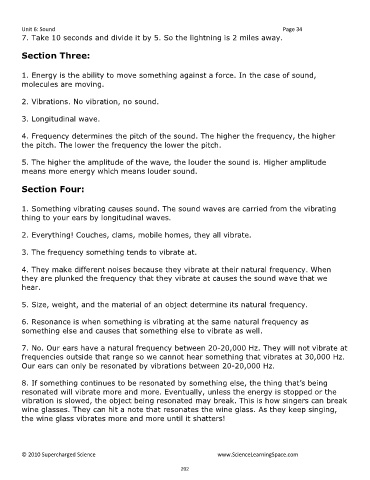Page 202 - Microsoft Word - LessonPlan-Overview.doc
P. 202
Unit 6: Sound Page 34
7. Take 10 seconds and divide it by 5. So the lightning is 2 miles away.
Section Three:
1. Energy is the ability to move something against a force. In the case of sound,
molecules are moving.
2. Vibrations. No vibration, no sound.
3. Longitudinal wave.
4. Frequency determines the pitch of the sound. The higher the frequency, the higher
the pitch. The lower the frequency the lower the pitch.
5. The higher the amplitude of the wave, the louder the sound is. Higher amplitude
means more energy which means louder sound.
Section Four:
1. Something vibrating causes sound. The sound waves are carried from the vibrating
thing to your ears by longitudinal waves.
2. Everything! Couches, clams, mobile homes, they all vibrate.
3. The frequency something tends to vibrate at.
4. They make different noises because they vibrate at their natural frequency. When
they are plunked the frequency that they vibrate at causes the sound wave that we
hear.
5. Size, weight, and the material of an object determine its natural frequency.
6. Resonance is when something is vibrating at the same natural frequency as
something else and causes that something else to vibrate as well.
7. No. Our ears have a natural frequency between 20-20,000 Hz. They will not vibrate at
frequencies outside that range so we cannot hear something that vibrates at 30,000 Hz.
Our ears can only be resonated by vibrations between 20-20,000 Hz.
8. If something continues to be resonated by something else, the thing that’s being
resonated will vibrate more and more. Eventually, unless the energy is stopped or the
vibration is slowed, the object being resonated may break. This is how singers can break
wine glasses. They can hit a note that resonates the wine glass. As they keep singing,
the wine glass vibrates more and more until it shatters!
© 2010 Supercharged Science www.ScienceLearningSpace.com
202

